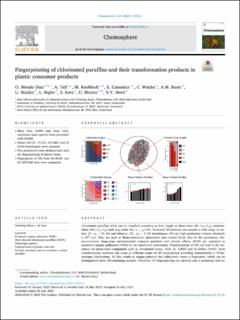Please use this identifier to cite or link to this item:
https://doi.org/10.21256/zhaw-28395Full metadata record
| DC Field | Value | Language |
|---|---|---|
| dc.contributor.author | Mendo Diaz, O. | - |
| dc.contributor.author | Tell, A. | - |
| dc.contributor.author | Knobloch, M. | - |
| dc.contributor.author | Canonica, E. | - |
| dc.contributor.author | Walder, C. | - |
| dc.contributor.author | Buser, A.M. | - |
| dc.contributor.author | Stalder, U. | - |
| dc.contributor.author | Bigler, L. | - |
| dc.contributor.author | Kern, S. | - |
| dc.contributor.author | Bleiner, D. | - |
| dc.contributor.author | Heeb, N.V. | - |
| dc.date.accessioned | 2023-08-04T14:08:13Z | - |
| dc.date.available | 2023-08-04T14:08:13Z | - |
| dc.date.issued | 2023-07-20 | - |
| dc.identifier.issn | 0045-6535 | de_CH |
| dc.identifier.issn | 1879-1298 | de_CH |
| dc.identifier.uri | https://digitalcollection.zhaw.ch/handle/11475/28395 | - |
| dc.description.abstract | Chlorinated paraffins (CPs) can be classified according to their length as short-chain (SC, C10-C13), medium-chain (MC, C14-C17) and long-chain (LC, C ≥ 18) CPs. Technical CP-mixtures can contain a wide range of carbon- (C-, nC = 10-30) and chlorine- (Cl-, nCl = 3-19) homologues. CPs are high-production volume chemicals (>106 t/y). They are used as flame-retardants, plasticizers and coolant fluids. Due to the persistence, bioaccumulation, long-range environmental transport potential and adverse effects, SCCPs are regulated as persistent organic pollutants (POPs) by the Stockholm Convention. Transformation of CPs can lead to the formation of unsaturated compounds such as chlorinated mono- (CO), di- (CdiO) and tri-olefins (CtriO). Such transformation reactions can occur at different stages of CP manipulation providing characteristic C-/Cl-homologue distributions. All this results in unique patterns that collectively create a fingerprint, which can be distinguished from CP-containing samples. Therefore, CP-fingerprinting can develop into a promising tool for future source apportionment studies and with it, the reduction of environmental burden of CPs and hazards to humans. Herein, CP-containing plastics were studied to establish fingerprints and develop this method. We analyzed four household items by reverse-phase liquid-chromatography coupled with a mass spectrometer with an atmospheric pressure chemical ionization source and an Orbitrap mass analyzer (RP-LC-APCI-Orbitrap-MS) operated at a resolution of 120000 (FWHM at m/z 200). MS-data of different CP-, CO-, CdiO- and CtriO-homologues were efficiently processed with an R-based automatic mass spectra evaluation routine (RASER). From the 16720 ions searched for, up to 4300 ions per sample were assigned to 340 C-/Cl-homologues of CPs and their transformation products. Specific fingerprints were deduced from the C-/Cl-homologues distributions, the carbon- (nC) and chlorine- (nCl) numbers and saturation degree. These fingerprints were compared with the ones obtained by a GC-ECNI-Orbitrap-MS method. | de_CH |
| dc.language.iso | en | de_CH |
| dc.publisher | Elsevier | de_CH |
| dc.relation.ispartof | Chemosphere | de_CH |
| dc.rights | https://creativecommons.org/licenses/by/4.0/ | de_CH |
| dc.subject | Fingerprinting of plastic material | de_CH |
| dc.subject | Homologue pattern | de_CH |
| dc.subject | Persistent organic pollutant (POP) | de_CH |
| dc.subject | R-based automatic spectra evaluation routine (RASER) | de_CH |
| dc.subject | Short-chained chlorinated paraffins (SCCPs) | de_CH |
| dc.subject | Plastic | de_CH |
| dc.subject | Consumer | de_CH |
| dc.subject.ddc | 540: Chemie | de_CH |
| dc.title | Fingerprinting of chlorinated paraffins and their transformation products in plastic consumer products | de_CH |
| dc.type | Beitrag in wissenschaftlicher Zeitschrift | de_CH |
| dcterms.type | Text | de_CH |
| zhaw.departement | Life Sciences und Facility Management | de_CH |
| zhaw.organisationalunit | Institut für Chemie und Biotechnologie (ICBT) | de_CH |
| dc.identifier.doi | 10.1016/j.chemosphere.2023.139552 | de_CH |
| dc.identifier.doi | 10.21256/zhaw-28395 | - |
| dc.identifier.pmid | 37480948 | de_CH |
| zhaw.funding.eu | No | de_CH |
| zhaw.issue | 139552 | de_CH |
| zhaw.originated.zhaw | Yes | de_CH |
| zhaw.publication.status | publishedVersion | de_CH |
| zhaw.volume | 338 | de_CH |
| zhaw.publication.review | Peer review (Publikation) | de_CH |
| zhaw.author.additional | No | de_CH |
| zhaw.display.portrait | Yes | de_CH |
| Appears in collections: | Publikationen Life Sciences und Facility Management | |
Files in This Item:
| File | Description | Size | Format | |
|---|---|---|---|---|
| 2023_MendoDiaz-etal_Fingerprinting-of-chlorinated-paraffins-plastic-consumer-products_Chemosphere.pdf | 7.68 MB | Adobe PDF |  View/Open |
Show simple item record
Mendo Diaz, O., Tell, A., Knobloch, M., Canonica, E., Walder, C., Buser, A. M., Stalder, U., Bigler, L., Kern, S., Bleiner, D., & Heeb, N. V. (2023). Fingerprinting of chlorinated paraffins and their transformation products in plastic consumer products. Chemosphere, 338(139552). https://doi.org/10.1016/j.chemosphere.2023.139552
Mendo Diaz, O. et al. (2023) ‘Fingerprinting of chlorinated paraffins and their transformation products in plastic consumer products’, Chemosphere, 338(139552). Available at: https://doi.org/10.1016/j.chemosphere.2023.139552.
O. Mendo Diaz et al., “Fingerprinting of chlorinated paraffins and their transformation products in plastic consumer products,” Chemosphere, vol. 338, no. 139552, Jul. 2023, doi: 10.1016/j.chemosphere.2023.139552.
MENDO DIAZ, O., A. TELL, M. KNOBLOCH, E. CANONICA, C. WALDER, A.M. BUSER, U. STALDER, L. BIGLER, S. KERN, D. BLEINER und N.V. HEEB, 2023. Fingerprinting of chlorinated paraffins and their transformation products in plastic consumer products. Chemosphere. 20 Juli 2023. Bd. 338, Nr. 139552. DOI 10.1016/j.chemosphere.2023.139552
Mendo Diaz, O., A. Tell, M. Knobloch, E. Canonica, C. Walder, A.M. Buser, U. Stalder, et al. 2023. “Fingerprinting of Chlorinated Paraffins and Their Transformation Products in Plastic Consumer Products.” Chemosphere 338 (139552). https://doi.org/10.1016/j.chemosphere.2023.139552.
Mendo Diaz, O., et al. “Fingerprinting of Chlorinated Paraffins and Their Transformation Products in Plastic Consumer Products.” Chemosphere, vol. 338, no. 139552, July 2023, https://doi.org/10.1016/j.chemosphere.2023.139552.
Items in DSpace are protected by copyright, with all rights reserved, unless otherwise indicated.